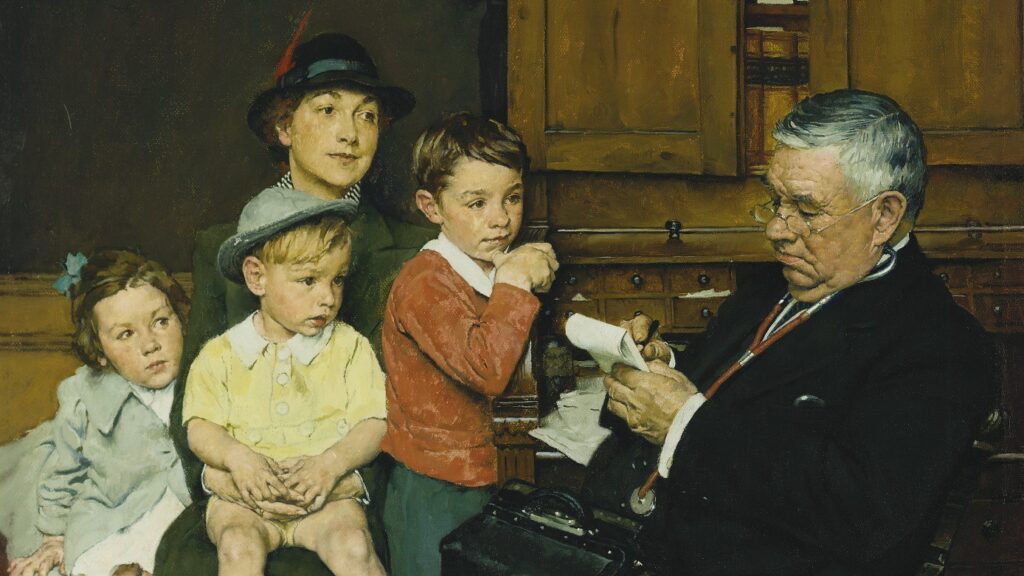[ad_1]
Norman Rockwell’s 1939 painting “When the Doctor Treats Your Child” depicts a family doctor with a stethoscope around his neck scribbling a prescription in front of three children, one sitting on his mother’s lap. The painting evokes the health care covenant: one doctor responsible for the family as well as for the community, whose professional ethics required unfaltering dedication to their patient’s well-being.
Health care delivery today bears little resemblance to that iconic painting. It has moved from a primary care model to team-based approaches in which care is delivered through a mosaic of handoffs that include primary care doctors, allied health professionals, covering doctors, and specialists. Most primary care clinicians have little time to spend with their patients and families, and so often miss clinically important insights and psychological and social factors that can be woven into the care they recommend. Nor are there enough hours in the day to deliver all the recommended care.
In Rockwell’s time, physicians were accountable not only to their patients and families but also to their communities. Indeed, professional livelihoods were often linked to reputation. Today, health care professionals must balance accountability to their patients with their accountability to other stakeholders, including health plans and employers; must pay attention to productivity metrics; and must be mindful to avoid interactions with the legal system.
advertisement
Acute and chronic illnesses were part of a patient’s care journey spanning careers and lifetimes. There was no ambiguity as to who was responsible for providing coordinated care recommendations — their doctor. Today, up to $80 billion a year of wasted health care spending is attributed to poor care coordination.
But perhaps the most concerning change is the erosion of a consistent human connection as part of the care experience, a sense that we as patients are fully understood by trusted professionals who genuinely care about us.
advertisement
Health care is evolving due to economics, variable quality, and an unsatisfactory consumer experience. The U.S. spends more than $4 trillion on health care each year, 25% of which is wasted. And the country does not achieve as much value on measures of health care system performance such as access to care, administrative efficiency, health equity, and health outcomes as other nations that spend far less.
Even in Rockwell’s seemingly idyllic portrait of a bygone era, the reality was far less than ideal. The actual care options were comparatively primitive while the quality of the care varied, as it does today. And commercial forces were already in play: Upjohn, the company that sponsored this painting, was trying to link its new synthetic pharmaceuticals to the trust of a family doctor (and Rockwell’s celebrity).
Consumers are rightfully unsatisfied, physicians are burning out, and health care continues its trajectory of unbridled spending. Change is needed and the market is delivering it — though it is not yet clear how the new care delivery approaches and the traditional ones will coexist or compete and how consumers will navigate among the options.
Health plans, medical providers, retail pharmacies, and myriad digital health tech businesses are experimenting with new care delivery models aimed at bending the cost curve, improving quality, offering a contemporary consumer experience and, in some instances, making a profit. Some are explicit attempts by employers and insurers to intercept potentially high-cost care and redirect it to more efficient venues. Others are targeting consumers directly with the promise of a better, lower-cost health care experience.
Americans increasingly entrust their care to apps and telemedicine providers whose credentials, accountability, and quality of care are opaque. The evolving health care market assumes that health care is a commodity that does not require long-term relationships, much less the need to abide by a covenant of care.
Consumers may benefit from having more options, but choosing among them will be challenging without trustworthy means to compare costs and quality. Where should one seek help for back pain, diabetes, or other acute or chronic problems: a telemedicine service recommended by an insurer? Amazon/One Medical, CVS Health, or the latest investor-backed health care bot powered by state-of-the-art artificial intelligence? How should care across these sites be coordinated? How can individuals be confident that these venues are committed to their well-being?
Alarming consequences of new health care delivery entrants have already emerged, such as inappropriate drug prescribing, when a business model becomes the dominant consideration in providing health care. Services aimed at reducing costs will find ways to do so — but caveat emptor.
There are ways forward. Organizations involved in selecting options for health insurance (such as employers) or delivering health care services should require understandable standards for quality of care and transparency around the qualifications of affiliated providers and institutions as well as the costs of care. Individuals should recognize they are purchasing products that do not have the reliability of commodity status. Buying health services is not like buying electricity; consumers must learn to navigate complexity and be savvy buyers. Systems to ensure that consistent, high-quality care is delivered regardless of setting must be advanced. This includes appropriate workflow tools, information services, quality standards, analytics, and adequate well-trained staff to ensure that consumers achieve optimized health outcomes wherever they receive care.
These efforts will, ideally, help us all rediscover that health care is truly a covenant and not a commodity.
Peter A. Bonis is the chief medical officer at Wolters Kluwer Health, a gastroenterologist, and an adjunct professor of medicine at Tufts University School of Medicine in Boston.
[ad_2]
Source link



